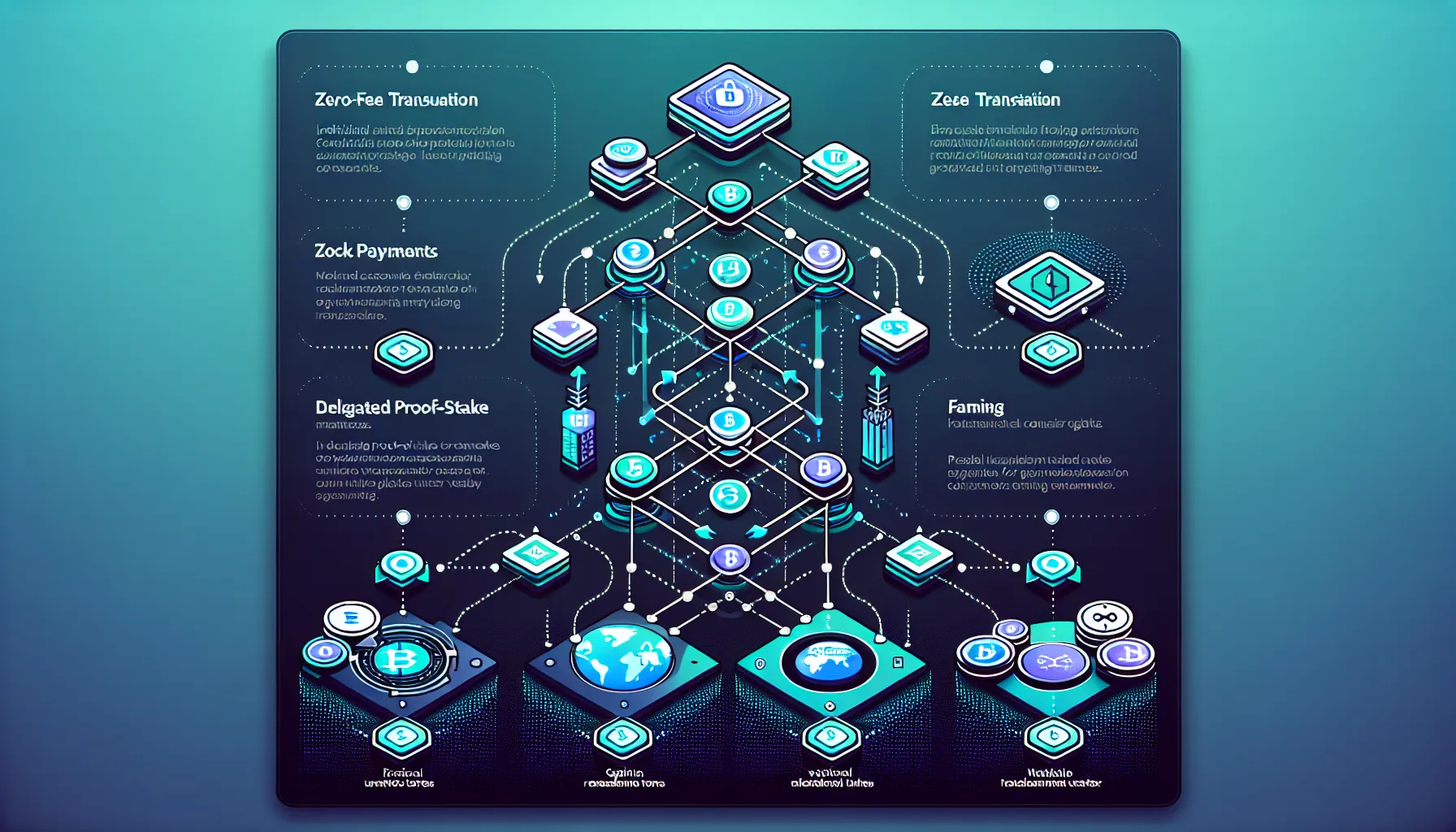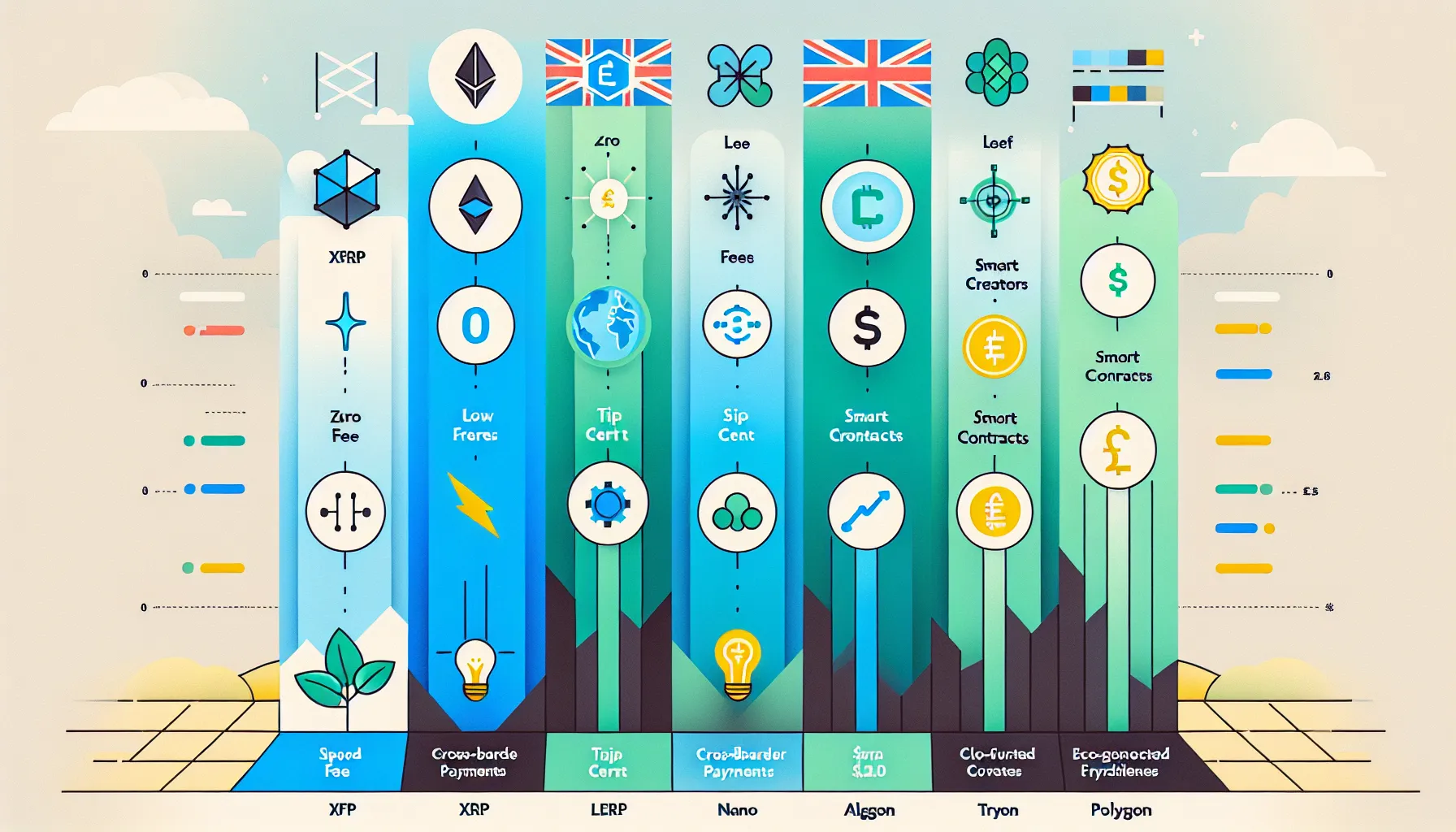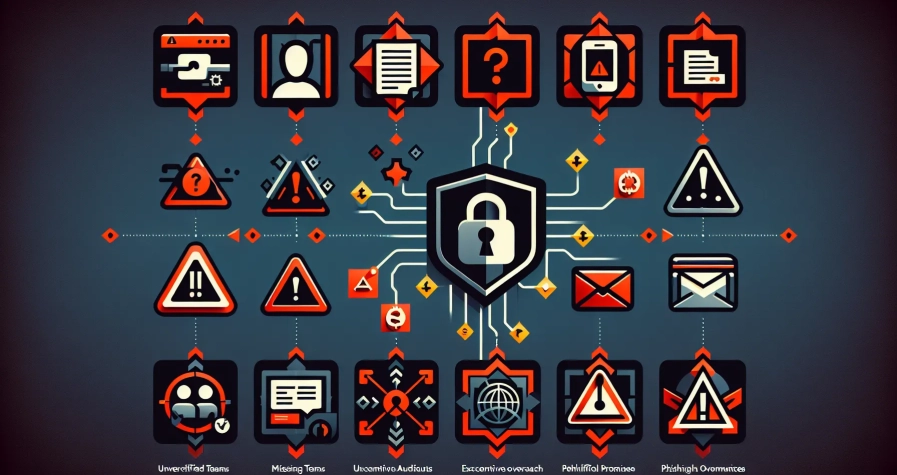Transaction fees can make or break the user experience in cryptocurrency. While some blockchains charge steep costs during peak times, sometimes exceeding £20 per transaction, others have engineered their networks specifically to keep fees negligible or even non-existent. For everyday users who want to send payments, tip creators, or transfer funds internationally without losing a significant portion to fees, choosing the right cryptocurrency matters enormously.
This guide explores 10 cryptos with the lowest fees for everyday users, examining how each network achieves its cost efficiency, typical fee structures, and the practical scenarios where these cryptocurrencies shine. Whether you’re looking for zero-fee micropayments or reliable cross-border remittances, these low-cost alternatives offer compelling solutions for regular use without the financial friction found on legacy payment rails or higher-fee blockchains.
Key Takeaways
- Transaction fees significantly impact cryptocurrency usability, with low-fee networks offering practical alternatives to blockchains charging £20 or more per transaction during peak times.
- Cryptos with the lowest fees like Nano offer genuinely zero transaction costs through innovative block-lattice architecture, whilst Stellar and XRP provide sub-penny fees ideal for cross-border payments.
- Networks such as Solana and Polygon deliver fast confirmations with fees under $0.01, making them accessible for everyday users engaging in DeFi, NFT trading, and frequent transfers.
- Litecoin and Bitcoin Cash serve as economical alternatives to Bitcoin, maintaining low fees even during network congestion for practical daily spending.
- Choosing the right low-fee cryptocurrency depends on matching specific use cases—whether international remittances, micropayments, smart contract interactions, or content monetisation—to each network’s technical strengths.
1. Nano (XNO): Zero-Fee Transactions

Nano stands apart in the cryptocurrency landscape by offering genuinely zero transaction fees, not negligible fees, but none whatsoever. This remarkable feature makes Nano particularly attractive for users who need to make frequent small transfers or microtransactions without worrying about costs eroding their funds.
How Nano Achieves Feeless Transfers
Nano’s feeless architecture stems from its unique block-lattice design, which fundamentally differs from traditional blockchain structures. Rather than all transactions competing for space in shared blocks, each Nano account maintains its own blockchain. When a user initiates a transaction, they update their own chain whilst the recipient updates theirs, eliminating the need for miners or validators who typically extract fees for processing transactions.
The network operates on a delegated proof-of-stake consensus mechanism, where representatives vote on transaction validity. These representatives, often run by community members and organisations, don’t receive financial compensation for their validation work, removing the economic pressure that creates fees in other networks. The result is a system where transactions can occur freely, regardless of amount or frequency.
Best Use Cases for Everyday Users
Nano excels in scenarios where micropayments and high-frequency transactions make sense. Content creators accepting tips, gamers making in-game purchases, or anyone sending small amounts across borders can use Nano without fee anxiety. Because there’s literally no minimum economical transaction size imposed by fees, users can send even a fraction of a penny without loss.
The instant settlement, transactions typically confirm in under a second, combined with zero fees makes Nano practical for point-of-sale payments and peer-to-peer transfers where speed and cost-efficiency matter equally. For everyday users frustrated with traditional payment processors taking percentages or other cryptocurrencies charging variable fees, Nano offers a refreshingly straightforward alternative.
2. Stellar (XLM): Minimal Costs for Global Payments
Stellar has built its reputation on facilitating affordable international payments, positioning itself as infrastructure for the financial inclusion of underbanked populations worldwide. With fees measured in fractions of a penny, Stellar makes cross-border transfers accessible to users who would otherwise face prohibitive costs through traditional remittance services.
Average Transaction Costs
Stellar’s transaction fees typically range from $0.0000035 to $0.00001 XLM per operation, functionally negligible for any practical purpose. These minimal fees serve primarily as an anti-spam mechanism rather than a revenue model, preventing network abuse whilst keeping legitimate transactions virtually free. Even during periods of high network activity, fees remain stable and predictable, unlike networks where congestion drives costs skyward.
The fee structure uses a base fee multiplied by the number of operations in a transaction, but most standard payments involve a single operation. This predictability helps users and businesses plan costs accurately, making Stellar particularly suitable for applications where fee variability would create budgeting challenges.
Cross-Border Payment Advantages
Stellar’s Stellar Consensus Protocol enables settlement in 3-5 seconds without expensive mining operations, making international transfers both fast and economical. The network supports built-in currency exchange through its decentralised exchange functionality, allowing users to send one currency whilst recipients receive another, all within the same low-fee transaction.
For remittances, where traditional services often charge 5-10% or more, Stellar represents a transformative alternative. Migrant workers sending money home, freelancers receiving international payments, or businesses paying overseas suppliers can all benefit from Stellar’s combination of speed, low cost, and multi-currency support. The network’s partnerships with financial institutions and payment providers further enhance its utility for real-world global payments.
3. XRP (Ripple): Fast and Affordable Transfers
XRP, the native token of the Ripple network, has established itself as a practical solution for users and institutions seeking fast, low-cost transactions. Originally designed to help institutional cross-border payments, XRP’s efficiency benefits everyday users equally well.
Fee Structure and Speed
Typical XRP transaction fees sit at approximately $0.0011, just over a tenth of a penny, making transfers economical regardless of amount. What truly distinguishes XRP, but, is the combination of low cost with exceptional speed: transactions finalise in 3-5 seconds, compared to minutes or hours on other networks.
This speed-cost combination stems from Ripple’s consensus protocol, which doesn’t rely on energy-intensive mining or lengthy block confirmation times. Instead, a network of trusted validators reaches consensus on transaction validity quickly and efficiently. The network can handle up to 1,500 transactions per second, ensuring fees remain stable even during busy periods, a persistent problem for some competing networks where demand spikes create fee auctions.
For everyday users, XRP offers particular value when time sensitivity matters. Paying a merchant, splitting a restaurant bill with friends, or settling a debt can all happen nearly instantaneously with minimal cost. The predictable fee structure means users can accurately calculate costs upfront, whilst the speed eliminates the awkward waiting period that accompanies slower cryptocurrency transfers. Financial institutions have recognised these advantages, but the same benefits apply whether you’re a bank moving millions or an individual sending twenty quid to a mate.
4. Litecoin (LTC): Lower Fees Than Bitcoin
Litecoin emerged in 2011 as the “silver to Bitcoin’s gold”, specifically designed to address Bitcoin’s limitations for everyday transactions. Whilst maintaining much of Bitcoin’s security model and philosophy, Litecoin optimised for practical usability through faster block times and lower fees.
Comparing Litecoin and Bitcoin Transaction Costs
Litecoin transaction fees typically remain below $0.01, often just a fraction of a penny, whilst Bitcoin fees frequently climb into several pounds during network congestion, sometimes reaching £20 or more. This dramatic difference stems from Litecoin’s faster block generation time (2.5 minutes versus Bitcoin’s 10 minutes) and resulting greater transaction capacity.
When Bitcoin’s mempool fills with pending transactions during busy periods, users must compete by offering higher fees to miners, creating a fee market where costs become unpredictable and often prohibitive for small transactions. Litecoin’s quadrupled block frequency provides more regular transaction processing opportunities, reducing congestion and keeping fees consistently low.
For everyday users, this cost difference matters enormously. Buying a coffee with Bitcoin during peak times might cost more in fees than the coffee itself: with Litecoin, the fee remains negligible regardless of market conditions. This practical advantage has helped Litecoin maintain relevance even though newer competitors, particularly amongst users who value Bitcoin’s security model but need more economical transactions. The network’s maturity, over a decade of consistent operation, combined with widespread exchange support makes Litecoin a reliable choice for regular payments and transfers without the cost anxiety that accompanies Bitcoin transactions.
5. Bitcoin Cash (BCH): Designed for Everyday Spending
Bitcoin Cash emerged from one of cryptocurrency’s most contentious debates: how to scale Bitcoin for mainstream transaction volumes. The result was a network specifically optimised for everyday spending with low fees and reliable confirmation times.
Why Bitcoin Cash Split From Bitcoin
In 2017, disagreement over Bitcoin’s scaling approach reached a breaking point. One camp advocated for larger block sizes to accommodate more transactions per block, directly increasing network capacity and reducing fees. The other favoured maintaining small blocks whilst building additional layers (like Lightning Network) atop Bitcoin’s base layer.
The Bitcoin Cash fork implemented the big-block approach, increasing maximum block size from 1MB to 8MB (later expanded further). This immediate capacity boost allowed more transactions per block, reducing competition for block space and keeping fees low even during busy periods. The philosophical divide centred on Bitcoin’s primary purpose: digital gold requiring maximum decentralisation versus peer-to-peer electronic cash for everyday transactions.
Real-World Transaction Fees
Bitcoin Cash transaction fees typically hover around $0.0024, less than a quarter of a penny, making the network practical for purchases ranging from a cup of coffee to larger acquisitions. The predictable fee structure means users can confidently send any amount without worrying whether fees will consume a significant portion.
This cost-efficiency has attracted merchant adoption, particularly amongst businesses seeking cryptocurrency payment options without the volatility of Bitcoin fees. Point-of-sale systems, online retailers, and peer-to-peer marketplace users benefit from knowing transaction costs won’t fluctuate wildly. For everyday users, Bitcoin Cash delivers on the original Bitcoin vision of digital cash for regular spending whilst maintaining the security benefits of proof-of-work consensus. The network’s maturity and Bitcoin brand recognition provide additional confidence for users exploring low-fee cryptocurrency options.
6. Cardano (ADA): Low-Cost Smart Contract Platform
Cardano combines low transaction fees with robust smart contract capabilities, offering users an economical platform for both simple transfers and more complex blockchain interactions. Built on peer-reviewed research and formal verification methods, Cardano emphasises sustainability alongside affordability.
Transaction Fee Breakdown
Cardano employs a deterministic fee structure based on transaction size and computational resources required, ensuring predictability. Standard ADA transfers typically cost well under $0.10, often just a few cents, whilst smart contract interactions remain affordable compared to networks like Ethereum where complex operations can cost tens of pounds.
The fee calculation uses a formula: minimum fee + (transaction size × price per byte). This transparent approach means users and developers can accurately calculate costs before submitting transactions, eliminating the guesswork and anxiety associated with gas fee estimation on other platforms.
Cardano’s Ouroboros proof-of-stake protocol underpins these low fees by removing energy-intensive mining from the equation. Validators (called stake pool operators) process transactions efficiently without the massive computational overhead that drives up costs on proof-of-work networks. The protocol’s design ensures security whilst maintaining economic efficiency, passing savings directly to users.
For everyday users, Cardano offers particular value when interacting with decentralised applications (DApps) or decentralised finance (DeFi) protocols built on the platform. Whilst simple peer-to-peer transfers cost pennies, even complex multi-step transactions involving smart contracts remain affordable, a stark contrast to Ethereum mainnet where similar operations might cost £50 or more during congestion. This accessibility makes Cardano appealing for users exploring blockchain applications beyond basic transfers without fear of prohibitive costs.
7. Algorand (ALGO): Eco-Friendly and Economical
Algorand distinguishes itself through a combination of environmental sustainability and economic efficiency, offering users a guilt-free, affordable blockchain experience. The network’s pure proof-of-stake consensus delivers both ecological benefits and consistently low transaction costs.
Fee Consistency and Network Speed
Algorand maintains stable, low transaction fees typically measured in fractions of a penny, with minimal variation regardless of network activity. This consistency stems from the network’s design philosophy: rather than allowing fee markets where users bid against each other during congestion, Algorand focuses on maintaining capacity to handle transaction volumes without creating artificial scarcity.
Transactions finalise in approximately 4.5 seconds, providing near-instant confirmation without sacrificing security or decentralisation. The pure proof-of-stake mechanism randomly selects validators from the entire pool of ALGO holders for each block, ensuring no small group can dominate consensus whilst eliminating the computational waste of mining-based systems.
Algorand’s carbon-negative status, achieved through carbon offset purchases exceeding the network’s minimal footprint, appeals to environmentally conscious users who want low-cost transactions without environmental guilt. The network’s technical efficiency means it requires far less energy per transaction than proof-of-work alternatives, directly contributing to lower operational costs that translate into lower fees.
For everyday users, Algorand offers reliable, affordable transactions with the added benefit of supporting environmental sustainability. Whether sending payments, participating in DeFi applications, or interacting with NFT marketplaces built on Algorand, users enjoy predictable costs and fast confirmations. The network’s institutional backing and growing ecosystem of applications provide additional confidence for users seeking a long-term, low-fee blockchain solution.
8. Solana (SOL): High Speed, Low Cost
Solana has captured attention through its remarkable combination of blazing-fast transaction speeds and rock-bottom fees, positioning itself as a high-performance blockchain for demanding applications and everyday users alike.
Average Fees Per Transaction
Solana’s average transaction fee sits at approximately $0.00063, not even a tenth of a penny, making it one of the most economical networks for any transaction type. This extraordinary affordability remains consistent even during periods of high activity, thanks to Solana’s massive throughput capacity.
The network achieves these metrics through a hybrid consensus mechanism combining proof-of-stake with proof-of-history, a cryptographic technique that timestamps transactions before they enter the blockchain. This innovation allows validators to process transactions in a predetermined order without extensive communication overhead, dramatically increasing efficiency.
Solana can theoretically handle up to 65,000 transactions per second, though real-world throughput typically operates well below this ceiling. Even so, this enormous capacity means transaction space rarely becomes scarce, preventing the fee bidding wars that plague networks with lower throughput. Users can consistently expect sub-penny fees regardless of what else is happening on the network.
For everyday users, Solana’s speed-cost combination enables use cases impractical on other blockchains. High-frequency trading on decentralised exchanges, gaming applications requiring numerous micro-transactions, NFT minting at scale, or simply sending payments to friends, all occur nearly instantaneously with negligible cost. The growing ecosystem of applications built on Solana, from DeFi protocols to social networks, benefits from this infrastructure whilst passing cost savings to end users. Whilst the network has experienced occasional growing pains with stability, its fundamental efficiency makes Solana compelling for users prioritising speed and affordability.
9. Tron (TRX): Affordable for Digital Content Creators
Tron carved out its niche by focusing on digital content and entertainment, building a blockchain optimised for the high-volume, small-value transactions common in media ecosystems. The network’s fee structure particularly benefits creators and consumers of digital content.
Fee Structure for Different Transaction Types
Tron charges $0.01 or less per transaction for standard transfers, but the real innovation lies in its resource model. Users who stake TRX tokens receive bandwidth and energy allocations, resources required for transactions and smart contract execution. With sufficient staked tokens, users can make numerous transactions completely free, only paying fees when their free allocations are exhausted.
This approach creates a two-tier system: casual users pay minimal fees, whilst active participants who stake TRX can transact extensively at no marginal cost. For content creators receiving numerous small payments from many users, or platforms processing high transaction volumes, staking provides economic efficiency whilst supporting network security through locked tokens.
Different transaction types consume varying amounts of bandwidth and energy. Simple TRC-20 token transfers (Tron’s equivalent to Ethereum’s ERC-20) might use more resources than basic TRX transfers, but even complex operations remain affordable compared to other smart contract platforms. The predictable resource consumption allows developers and users to optimise their staking strategies, balancing locked capital against transaction cost savings.
For digital content creators, whether musicians, writers, video producers, or other artists, Tron’s model facilitates micropayment monetisation that would be uneconomical on high-fee networks. Fans can tip creators tiny amounts, purchase individual pieces of content, or make frequent small payments without fees consuming substantial percentages. This frictionless value transfer aligns perfectly with content monetisation models, making Tron particularly relevant for the creator economy and entertainment applications.
10. Polygon (MATIC): Ethereum’s Low-Fee Alternative
Polygon has emerged as the leading solution for users who want Ethereum’s ecosystem and security whilst avoiding its notorious gas fees. By moving transactions off Ethereum’s congested mainnet, Polygon delivers the best of both worlds: access to Ethereum’s applications with dramatically reduced costs.
How Polygon Reduces Ethereum Gas Fees
Polygon operates as a Layer 2 scaling solution, processing transactions on its own chain before periodically settling batches of transactions back to Ethereum mainnet. This architecture means individual transactions don’t compete for space in Ethereum blocks, eliminating the fee auctions that drive mainnet costs into the stratosphere during busy periods.
The network uses a modified proof-of-stake consensus mechanism with a set of validators processing transactions at high speed and low cost. Fees typically amount to a fraction of a penny per transaction, sometimes less than $0.01, compared to Ethereum mainnet where even simple transfers can cost £5-£50 depending on network congestion.
Users bridge assets from Ethereum to Polygon, then transact freely on Polygon’s network with minimal fees. When they want to return assets to Ethereum mainnet (perhaps to access applications not yet available on Polygon), they bridge back. Whilst bridging incurs some cost, users who conduct multiple transactions on Polygon save dramatically overall.
Practical Applications for Daily Users
Polygon’s affordability opens Ethereum’s vast ecosystem to everyday users previously priced out by gas fees. Decentralised finance protocols, NFT marketplaces, gaming applications, social networks, and countless other DApps operate on Polygon, offering familiar experiences at practical costs.
For users interested in DeFi, swapping tokens, providing liquidity, or yield farming, Polygon makes experimentation affordable. On Ethereum mainnet, a series of transactions to enter a liquidity position might cost £100 in gas fees alone: on Polygon, the same operations cost pennies. This accessibility democratises DeFi participation beyond wealthy users who can absorb high fees.
NFT enthusiasts benefit similarly, able to mint, buy, and trade digital collectibles without fee anxiety. Gaming applications running on Polygon can process numerous in-game transactions without players worrying about costs, enabling blockchain gaming experiences that feel more like traditional games.
For everyday users, Polygon represents a practical entry point into Ethereum’s ecosystem, all the applications and opportunities, without the prohibitive costs that make mainnet increasingly impractical for regular use.
Conclusion
Transaction fees shouldn’t be an afterthought when choosing a cryptocurrency for everyday use, they fundamentally shape whether blockchain technology feels practical or frustrating. The ten cryptocurrencies explored here demonstrate that low-cost, efficient transactions are entirely achievable without sacrificing security or functionality.
Nano and Stellar stand out for users prioritising the absolute lowest fees, offering zero or near-zero costs ideal for micropayments and frequent transfers. XRP combines affordability with exceptional speed, whilst Litecoin and Bitcoin Cash provide low-fee alternatives to Bitcoin with broader merchant acceptance. For users exploring smart contracts and decentralised applications, Cardano, Algorand, Solana, and Polygon deliver affordable access to programmable blockchain functionality. Tron offers particular value for content creators and entertainment applications through its unique resource model.
Each network achieves its efficiency through different technical approaches, from Nano’s block-lattice architecture to Polygon’s Layer 2 scaling, proving multiple paths exist to the same destination: practical, affordable blockchain transactions for everyday users. When selecting among these options, consider your specific use case: international remittances, frequent small payments, DeFi participation, or content monetisation. The right low-fee cryptocurrency depends on matching network strengths to individual needs, but any of these ten options offers dramatic improvements over high-fee alternatives and traditional payment systems alike.
Frequently Asked Questions
Which cryptocurrency has absolutely zero transaction fees?
Nano (XNO) offers genuinely zero transaction fees, not just negligible costs. Its unique block-lattice architecture allows each account to maintain its own blockchain, eliminating miners and validators who typically charge fees, making it ideal for micropayments and frequent transfers.
How much does it cost to send an international payment using Stellar?
Stellar transaction fees range from $0.0000035 to $0.00001 XLM per operation, essentially negligible. This makes Stellar transformative for remittances, where traditional services charge 5–10% or more, whilst transactions settle in just 3–5 seconds across borders.
What are the lowest fee cryptos for everyday users in 2025?
The top low-fee cryptocurrencies include Nano (zero fees), Stellar and XRP (fractions of a penny), Solana ($0.00063), Litecoin and Bitcoin Cash (under $0.01), and Polygon (pennies). Each offers practical, affordable transactions without the high costs of Bitcoin or Ethereum mainnet.
Why is Polygon cheaper than Ethereum for transactions?
Polygon operates as a Layer 2 scaling solution, processing transactions on its own chain before batching settlements to Ethereum mainnet. This eliminates competition for Ethereum block space, reducing typical fees from £5–£50 down to fractions of a penny per transaction.
Can you make free cryptocurrency transactions by staking tokens?
Yes, Tron allows users who stake TRX tokens to receive bandwidth and energy allocations for free transactions. This benefits content creators and high-volume users who can transact extensively at no marginal cost once they’ve staked sufficient tokens.
Are low-fee cryptocurrencies secure enough for daily use?
Absolutely. Low-fee cryptocurrencies like Cardano, Algorand, and XRP use advanced consensus mechanisms (proof-of-stake, consensus protocols) that maintain robust security without energy-intensive mining. Many have operated reliably for years, proving their security models whilst keeping costs minimal for everyday users.








